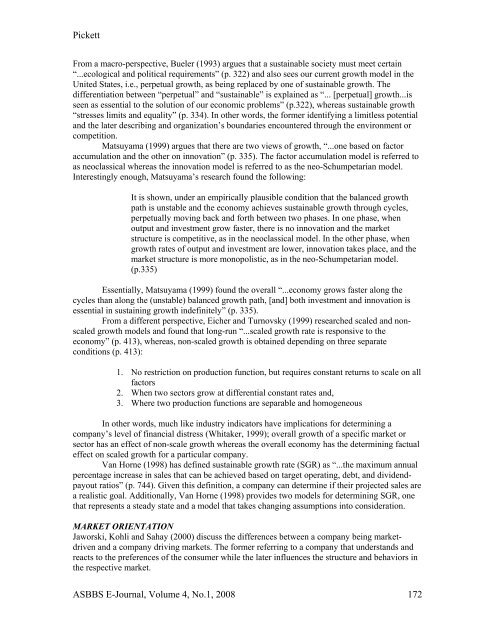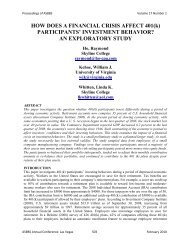stock repurchase announcements: a test of market ... - Asbbs.org
stock repurchase announcements: a test of market ... - Asbbs.org
stock repurchase announcements: a test of market ... - Asbbs.org
You also want an ePaper? Increase the reach of your titles
YUMPU automatically turns print PDFs into web optimized ePapers that Google loves.
Pickett<br />
From a macro-perspective, Bueler (1993) argues that a sustainable society must meet certain<br />
“...ecological and political requirements” (p. 322) and also sees our current growth model in the<br />
United States, i.e., perpetual growth, as being replaced by one <strong>of</strong> sustainable growth. The<br />
differentiation between “perpetual” and “sustainable” is explained as “... [perpetual] growth...is<br />
seen as essential to the solution <strong>of</strong> our economic problems” (p.322), whereas sustainable growth<br />
“stresses limits and equality” (p. 334). In other words, the former identifying a limitless potential<br />
and the later describing and <strong>org</strong>anization’s boundaries encountered through the environment or<br />
competition.<br />
Matsuyama (1999) argues that there are two views <strong>of</strong> growth, “...one based on factor<br />
accumulation and the other on innovation” (p. 335). The factor accumulation model is referred to<br />
as neoclassical whereas the innovation model is referred to as the neo-Schumpetarian model.<br />
Interestingly enough, Matsuyama’s research found the following:<br />
It is shown, under an empirically plausible condition that the balanced growth<br />
path is unstable and the economy achieves sustainable growth through cycles,<br />
perpetually moving back and forth between two phases. In one phase, when<br />
output and investment grow faster, there is no innovation and the <strong>market</strong><br />
structure is competitive, as in the neoclassical model. In the other phase, when<br />
growth rates <strong>of</strong> output and investment are lower, innovation takes place, and the<br />
<strong>market</strong> structure is more monopolistic, as in the neo-Schumpetarian model.<br />
(p.335)<br />
Essentially, Matsuyama (1999) found the overall “...economy grows faster along the<br />
cycles than along the (unstable) balanced growth path, [and] both investment and innovation is<br />
essential in sustaining growth indefinitely” (p. 335).<br />
From a different perspective, Eicher and Turnovsky (1999) researched scaled and nonscaled<br />
growth models and found that long-run “...scaled growth rate is responsive to the<br />
economy” (p. 413), whereas, non-scaled growth is obtained depending on three separate<br />
conditions (p. 413):<br />
1. No restriction on production function, but requires constant returns to scale on all<br />
factors<br />
2. When two sectors grow at differential constant rates and,<br />
3. Where two production functions are separable and homogeneous<br />
In other words, much like industry indicators have implications for determining a<br />
company’s level <strong>of</strong> financial distress (Whitaker, 1999); overall growth <strong>of</strong> a specific <strong>market</strong> or<br />
sector has an effect <strong>of</strong> non-scale growth whereas the overall economy has the determining factual<br />
effect on scaled growth for a particular company.<br />
Van Horne (1998) has defined sustainable growth rate (SGR) as “...the maximum annual<br />
percentage increase in sales that can be achieved based on target operating, debt, and dividendpayout<br />
ratios” (p. 744). Given this definition, a company can determine if their projected sales are<br />
a realistic goal. Additionally, Van Horne (1998) provides two models for determining SGR, one<br />
that represents a steady state and a model that takes changing assumptions into consideration.<br />
MARKET ORIENTATION<br />
Jaworski, Kohli and Sahay (2000) discuss the differences between a company being <strong>market</strong>driven<br />
and a company driving <strong>market</strong>s. The former referring to a company that understands and<br />
reacts to the preferences <strong>of</strong> the consumer while the later influences the structure and behaviors in<br />
the respective <strong>market</strong>.<br />
ASBBS E-Journal, Volume 4, No.1, 2008 172

















